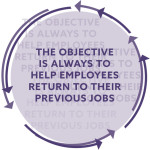 Most workers’ compensation claims do not start out as complex. They become complex over time due to specific drivers that increase costs and duration. Being able to recognize and resolve these drivers at the right time will help reduce a claim’s likelihood of becoming complex. Read on to learn how to recognize risk factors and pick up some tips on how you can have greater impact in changing the trajectory of potentially complex claims.
Most workers’ compensation claims do not start out as complex. They become complex over time due to specific drivers that increase costs and duration. Being able to recognize and resolve these drivers at the right time will help reduce a claim’s likelihood of becoming complex. Read on to learn how to recognize risk factors and pick up some tips on how you can have greater impact in changing the trajectory of potentially complex claims.
Litigation
It is no secret that litigation is a key driver of claim complexity, cost and duration. A California Workers’ Compensation Institute (CWCI) survey shows:
- Claims with attorney involvement are eight times more expensive
- Lost time days are three times higher
- 90% of litigated claims result in permanent impairment
Strategies and tools around litigation avoidance are critical. An injured worker can become anxious about their recovery and the ability to sustain themselves and their family. Being an advocate for the injured employee can make all the difference. Providing excellent customer service, making claim decisions faster, facilitating effective meaningful communication and following through with impactful actions will reduce litigation. Take the time to learn about the person at the heart of the claim and find ways to best address their needs and alleviate concerns. It is important to customize your approach and resources for the individual injured employee.
Opioids
Another well-known cause of complexity is opioid utilization. In an interview with DMEC @Work, Dr. Teresa Bartlett of Sedgwick reported the following data:
- According to the Centers for Disease Control and Prevention, 78 people die every day from the opioid epidemic
- Sedgwick’s data shows that 56% of injured workers take opioids and, on average, have a 53-week increase in claim duration when opioids are involved
- 60% of individuals taking an opioid for 90 days will still be taking them 5 years later
In response to the opioid epidemic, several states have enacted formularies, prospective utilization review, limitations on the first fill and enforcement of tracking systems like CURES and ISTOP. Sedgwick provides an effective approach through our complex pharmacy team in recognizing harmful prescribing trends and working with physicians in weaning injured workers off of opioids. These are all necessary mitigation strategies, but ultimately the best approach is to stop potentially harmful practices at the source. Initial efforts should be focused on utilizing good quality physicians and holding them accountable. Sedgwick’s provider benchmarking and search tool helps in identifying physicians we know will do the right thing by their patients. It also flags physicians that have adverse prescribing habits. We want to line up providers who share the same goal: to help the injured worker receive the best possible care and get them back to being healthy and productive.
Comorbidities
The existence of comorbidities adds another layer of complexity to a claim. A two-year study was recently conducted by Harbor Health on injured workers with obesity, hypertension, history of drug addiction and tobacco use. It found the following:
- Claim durations increased by 76% for claims involving multiple comorbidities
- Incurred costs increased by 341%
- Temporary total disability (TTD) days increased by 285%
- Litigation rates increased by 147%, and jumped to 224% when addiction-related issues were present
- Surgical rates increased 123%
An optimal recovery demands early intervention and a holistic approach. Coordination with clinical resources is necessary in understanding and articulating what is related to the injury, what is pre-existing and what is complicating recovery. That is why our team of experts coordinates with all stakeholders and maps out a more holistic treatment plan to secure recovery and achieve our goals.
Psychosocial issues
Much like comorbid conditions, unidentified psychosocial issues will lead to increased costs and delayed recovery. A recent study presented by The Hartford and Optum shows:
- Duration increases 57% when the injured worker is depressed
- 10% of claims with psychosocial issues cause 60% of claim costs
- 97% of depressed patients have a second comorbid condition
We can best support individuals dealing with psychosocial challenges by changing our approach in helping them cope with an injury. As discussed with litigation avoidance, advocacy can have a significant impact in successfully managing their claims. Also, we need to start taking a more holistic approach and focus on the whole person when promoting a return to health. Cognitive behavioral therapy can be a useful tool. For instance, at Sedgwick we utilize the expertise of our team of behavioral health specialists, who play a key role in assisting injured workers with management of psychosocial issues and coping skills during the recovery process.
Understanding the basics of complex claims can help you in accessing the right resources to avoid or mitigate these root causes. If you have questions or comments for our complex claims unit please leave us a comment and we’ll be glad to research.
Eddy Canavan, VP, Workers’ Compensation Practice & Compliance
Read additional Sedgwick thought leader articles on complex claims in our edge magazine: